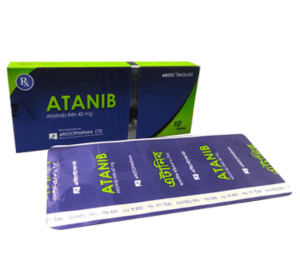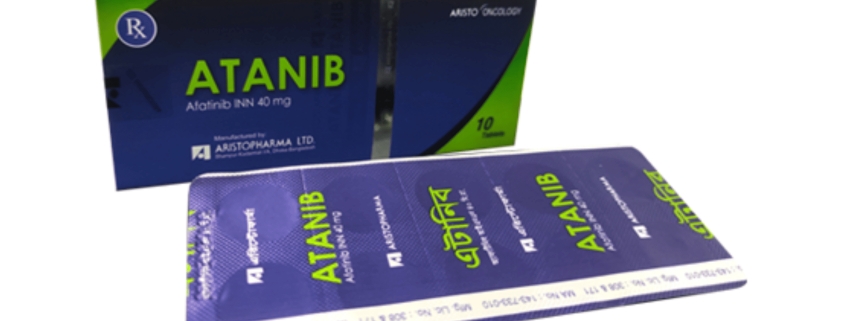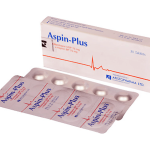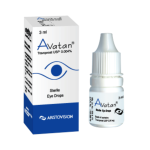Atanib (Afatinib)

Therapeutic Group : Tyrosine Kinase Inhibitor (Oncology)
Presentation:
ATANIB 40 mg Tablet: Each film coated tablet contains Afatinib Dimaleate INN 59.12 mg equivalent to Afatinib 40 mg.
Pharmacology:
Mechanism of action: Afatinib covalently binds to the kinase domains of EGFR (ErbB1), HER2 (ErbB2) and HER4 (ErbB4) and irreversibly inhibits tyrosine kinase autophosphorylation, resulting in downregulation of ErbB signaling. Afatinib demonstrated inhibition of autophosphorylation and/or in vitro proliferation of cell lines expressing wild-type EGFR and in those expressing selected EGFR exon 19 deletion mutations, exon 21 L858R mutations, or other less common non-resistant mutations, at Afatinib concentrations achieved in patients. In addition, Afatinib inhibits in vitro proliferation of cell lines overexpressing HER2.
Pharmacokinetics: Absorption: Following oral administration of Afatinib, time to peak plasma concentrations (Tmax) is 2 to 5 hours. Maximum concentration (Cmax) and area under the concentration-time curve from time zero to infinity (AUCo- ) values increased slightly more than dose proportional in the range of 20 to 50 mg. A high-fat meal decreased Cmax by 50% and AUCo- by 39% relative to the fasted condition. Distribution: In vitro binding of Afatinib to human plasma proteins is approximately 95%. Metabolism: Covalent adducts to proteins are the major circulating metabolites of Afatinib and enzymatic metabolism of Afatinib is minimal. Elimination: In humans, excretion of Afatinib is primarily via the faeces. Following administration of an oral solution of 15 mg Afatinib, 85.4% of the dose was recovered in the faeces and 4.3% in urine. The elimination half-life of Afatinib is 37 hours after repeat dosing in cancer patients. Steady-state plasma concentrations are achieved within 8 days of repeat dosing of Afatinib resulting in an accumulation of 2.8-fold for AUC and 2.1-fold for Cmax.
Indications:
1. First-line treatment of patients with metastatic non-small cell lung cancer (NSCLC) whose tumors have non-resistant epidermal growth factor receptor (EGFR) mutations as detected by an FDA-approved test. Safety and efficacy of Afatinib were not established in patients whose tumors have resistant EGFR mutations.
2. Treatment of patients with metastatic, squamous NSCLC progressing after platinum-based chemotherapy.
Dosage & Administration:
1.The recommended dose of Atanib is 40 mg orally, once daily until disease progression or no longer tolerated by the patient. For the patients with severe renal impairment, the recommended dose is 30 mg orally, once daily.
2. Atanib should be taken at least 1 hour before or 2 hours after a meal. Advise patients not to take a missed dose within 12 hours of the next dose.
Contrainidications:
None
Warning & Precautions:
Side effects:
Most common adverse reactions (>20%) are diarrhoea, rash/acneiform dermatitis, stomatitis, paronychia, dry skin, decreased appetite, nausea, vomiting, pruritus.
Drug interaction:
Co-administration of P-glycoprotein (P-gp) inhibitors (including but not limited to ritonavir, cyclosporine A, ketoconazole, itraconazole, erythromycin, verapamil, quinidine, tacrolimus, nelfinavir, saquinavir, and amiodarone) can increase Afatinib exposure. Reduce Afatinib dose by 10 mg per day if not tolerated. Resume the previous dose after discontinuation of the P-gp inhibitor as tolerated. Co-administration of chronic P-gp inducers (including but not limited to rifampicin, carbamazepine, phenytoin, phenobarbital, and St. John\\\\\\\\\\\\\\\’s wort) orally can decrease Afatinib exposure. Increase Afatinib dose by 10 mg per day as tolerated. Resume the previous dose 2 to 3 days after discontinuation of the P-gp inducer.
Use in special groups:
Pregnancy: Based on findings from animal studies and its mechanism of action, Afatinib can cause fetal harm when administered to a pregnant woman. There are no available data on the use of Afatinib in pregnant women. Animal studies resulted in embryotoxicity, maternal toxicity, and increased abortions at late gestational stages. Advise females of reproductive potential to use effective contraception during treatment with Afatinib and for at least 2 weeks after the last dose of Afatinib.
Nursing mothers: Advise women not to breastfeed during treatment with Afatinib and for 2 weeks after the last dose of Afatinib.
Pediatric use: Safety and effectiveness of Afatinib in pediatric patients have not been established.
Geriatric use: No overall differences in safety were observed between patients 65 years and older and younger patients.
Hepatic toxicity: Monitor with periodic liver testing. Withhold or discontinue Afatinib for severe or worsening liver tests.
Renal impaired patients: Patients with severe renal impairment have a higher exposure to Afatinib. Administer Afatinib at a starting dose of 30 mg once daily in patients with severe renal impairment (not necessary in patients with mild or moderate renal impairment).
Diarrhoea: Diarrhoea may result in dehydration and renal failure. Withhold Afatinib for severe and prolonged diarrhoea not responsive to antidiarrhoeal agents. Bullous and exfoliative skin disorders: Severe bullous, blistering, and exfoliating may occur. Discontinue for life- threatening cutaneous reactions. Withhold Afatinib for severe and prolonged cutaneous reactions.
Interstitial lung disease (ILD): Withhold Afatinib for acute onset or worsening of pulmonary symptoms. Discontinue Afatinib if ILD is diagnosed.
Keratitis: Withhold Afatinib for keratitis evaluation. Withhold or discontinue Afatinib for confirmed ulcerative keratitis.
Storage:
Store at 25°C. Keep in a dry place away from light.
Packing:
ATANIB 40 mg Tablet: Each box contains 10 ATANIB tablets in Alu-Alu blister pack.



